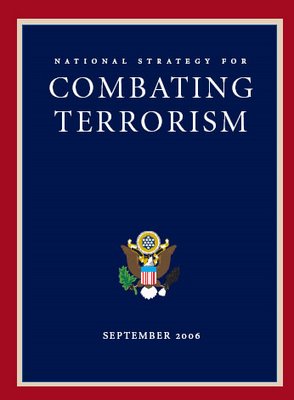Bad Report Card

The White House has issued yet another red, white, and blue official report in their series of documents in the "National Strategy" genre, which follows the National Strategy for Victory in Iraq and the National Security Strategy in its ham-fisted information design. Tellingly, at least one of these Bush reports was type-set in "Minion, semi-bold," according to font maven Ellen Lupton.
There are two things to notice about the "National Strategy for Combating Terrorism" from a digital rhetoric standpoint:
1) It uses much of the same PowerPoint corporate-speak that got a similar administration document slammed by Paul Krugman in his editorial on "Bullet Points Over Baghdad." Of course, this booklet is a little more subtle: it only uses bullet points, boldface, and italics . . . not bullet points, check marks, arrows, boldface, italics, and underlining like the visually chaotic Iraq document that Krugman takes apart. But it is exactly the kind of stunted prose that has caused Edward Tufte to declare that "PowerPoint is Evil."
2) It harps on how terrorists use the World Wide Web for propaganda in ways that anyone who remembers the Sonic Jihad fiasco should be skeptical about. (If you don't know what the Sonic Jihad debacle in Congress was, you can watch this Nightline episode or read my longer analysis of what went wrong when a Battlefield 2 fan film with a joke Team America soundtrack was mistakenly shown as evidence of jihadist recruiting techniques.) The "Internet" is mentioned eight times as an avenue for nefarious plotting. As you can see from this sample passage, these web-savvy jihadists are used as justification for both more surveillance and more taxpayer-funded digital propaganda.
Cyber safehavens. The Internet provides an inexpensive, anonymous, geographically unbounded, and largely unregulated virtual haven for terrorists. Our enemies use the Internet to develop and disseminate propaganda, recruit new members, raise and transfer funds, train members on weapons use and tactics, and plan operations. Terrorist organizations can use virtual safehavens based anywhere in the world, regardless of where their members or operatives are located. Use of the Internet, however, creates opportunities for us to exploit. To counter terrorist use of the Internet as a virtual sanctuary, we will discredit terrorist propaganda by promoting truthful and peaceful messages. We will seek ultimately to deny the Internet to the terrorists as an effective safehaven for their propaganda, proselytizing, recruitment, fundraising, training, and operational planning.
Right now the government is apparently accepting bids for public relations efforts in Iraq on behalf of the U.S. Government. Perhaps there could be another successor to the astonishingly inept Lincoln Group after the secretive Rendon Group also choked on this public diplomacy job!
You can see how far we've come from the 2003 National Strategy for Combating Terrorism, which at least paid lip service to the role of "underlying conditions" in the promulgation of terrorist ideology.

Labels: government reports, powerpoint politics, public diplomacy

1 Comments:
Great post. The "terrorism pyramid" at the end is amazing -- there is a connection somewhere here to the food pyramid ... (Did you ever notic that "underlying conditions" holds the same place as carbs on the food pyramid...?) The quote from the terrorism report concerning the Internet is extremely telling about the evidentiary habits of the current administration. And fonts are always fun ...
Post a Comment
<< Home